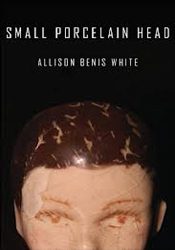
Allison Benis White’s second book of poems, Small Porcelain Head shows death, particularly the suicide of her dear friend, as both a personal and phenomenological rupture. How does a poet even write about suicide? How does she encode such trauma in a poem? How does she work the ugly, raw qualities of her confusion and pain from her body? How, for example, does she express the futility she must have felt after the fleeting urge to go back in time and save her friend? By way of clean, lucent diction, White circles the energies released by the urgency of these hard questions. In 44 prose poems, White’s speaker obsesses about her deceased friend—a woman once living, breathing, possessing agency—but who now exists for her only as an object of loss, as memory traces wandering the circuits of her limbic system. Over time the friend’s physical absence must have remained unapproachable, we imagine, and soon uncontainable energies must have left White’s QWERTY fingers to fill the rift between here and gone, to do as Keats suggests, and “fill some other body” through a regenerative act of the imagination. White’s poems illustrate her self-reflexive process of working through grief via the interlocutions of her speaker, a woman who fixates on handcrafted porcelain dolls, as she remembers them from her childhood, and sees them on display in a repair shop window. Specifically, White has written small, boxy poems and filled them with gorgeous, uncanny language adorned with hand-sewn and -painted ideas, which become curiosities like the dolls themselves, which each small, cabinet-like poem cannot contain.
Open texts, White’s poems do not close like doors; instead, she carries notions from one poem to the next like reflections transposed onto glass. “God does not make sense, is never quiet” overlaps with the poem on the following page: “And she would talk when the string was pulled, without opening her mouth, just a voice from a record, a slot on the inside of her chest.” In each poem, White’s speaker talks about a remembered porcelain doll, or a window display of them, as a way to dovetail the trauma she and her speaker each feel over the friend’s sudden death.
The speaker, often speaking from a regressed state of her girlhood, projects all of this excess energy into the description of a timeworn porcelain doll. In her grief, she remembers details of the doll’s face, torso and appendages to create a literal figure to not only help her understand why her friend took her life, but also to witness her trauma. “I want to say something that will look at me,” she writes in one of the book’s untitled poems, and the reader understands that she wants to make a doll for us that anthropomorphizes the most difficult-to-articulate qualities of her loss. In the second poem, we see how the doll works as a talisman, or medium, through which the speaker externalizes her loss:
What is left but obsession, handling the object over and over? My hands fit around her waist.
Unbuttoning, I wanted nothing to happen or the same thing to happen forever in the same place.
Soon the object must grow or become invisible, so familiar it is so hollow you are inside.
More along these lines, from later in the series:
Because the pain is company. Because the operator activates the body like a glove puppet.
Because the novelty wears off quickly and the hand, withdrawn, leaves the body exhausted.
White gets at how our desire, wonder and joy fill the things and people we love until we overvalue them. Until we fill them so completely they are an extension of us. So that their dissolution and annihilation, she suggests by way of negative capability, will become our own.
Throughout the five-part, book-length series, the speaker weaves the friend’s suicide note in with rhetorical statements mimetic of a troubled psychological state. The note itself seems ripped to shreds, almost destroyed by the impact of her reading it: “If pain is a desire for dark shapes, even when dried, glistening, if you are reading this” (the italics are mine). We read this fragment of the friend’s last words in the first poem. In the last poem, we see a complete sentence from the whole note pieced together: “By the time you read this, the letter began, someone has already called out, opened the door”. This complete sentence comes full circle, and is as close as the speaker’s obsessive work will come, we realize, to closure.
Throughout, repeated, fragmentary if this, then that constructions express a psyche haunted by the ghost of logic, or the underdeveloped syntax of a child: “If pain is only weakness leaving the body…”; “If you are reading this…”; “If death is turning away”. These often-fallacious contingencies, juxtaposed with vivid description of the doll, register the speaker’s anxiety because they betray her urge to go back to the moments before the suicide to stop the clock. Since there is no way to really return, since the friend now exists only in memory, the speaker’s fixations on the doll functions as a substitute for the lost love object. While a new doll might soothe the nervous child within the speaker’s psyche, the adult speaker, in her grief, re-imagines the doll as a thing in a broken, fecalized state of decay. These dolls become, by the book’s middle sections, the emotional negative space around what the doll meant to the speaker when it was new, when she, as a child, was unaware of death. The aging doll not only represents death, but also the speaker’s anxious awareness of transience, of change, as well as her fixed idea that over time her body, like the doll’s, will succumb to entropy. She also questions the permanence of the human spirit and wonders, implicitly, if it exists as an energy within us that diminishes as we age. A life force that moves us to be, to connect with one another, so long as the body contains it. “If there is no God, only white streamers left over from evening, collected like women who have fainted.”
 White’s poems are most stunning when they get at the agency invested in the doll’s thingness, a handmade object, which the doll maker crafted with care. While every doll is merely an object representing a baby, human hands made it in good faith for a child to enjoy. White’s sense of integrity parallels that of the doll maker’s: “If description is a living thing, dark cherry hair and glass eyes, tilted away”; and “A wooden hand is a hand without fingernails, sanded palm and the color of skin, an oar rowing in air. Then a windmill, from the hand. As in human profiles cut into trees with a knife”. White wants her description of the dolls to look alive, to call to mind a careful, as opposed to reckless, psychological field of representation. This care is not without its opposite, which is the absence of care, the ordinary violence of being with others: “Because to live is to be entered vertically and repeatedly, the pain is love and making me.” Since love and care for others moves the hands that make the dolls, White implies, hope survives death and material dissolution.
White’s poems are most stunning when they get at the agency invested in the doll’s thingness, a handmade object, which the doll maker crafted with care. While every doll is merely an object representing a baby, human hands made it in good faith for a child to enjoy. White’s sense of integrity parallels that of the doll maker’s: “If description is a living thing, dark cherry hair and glass eyes, tilted away”; and “A wooden hand is a hand without fingernails, sanded palm and the color of skin, an oar rowing in air. Then a windmill, from the hand. As in human profiles cut into trees with a knife”. White wants her description of the dolls to look alive, to call to mind a careful, as opposed to reckless, psychological field of representation. This care is not without its opposite, which is the absence of care, the ordinary violence of being with others: “Because to live is to be entered vertically and repeatedly, the pain is love and making me.” Since love and care for others moves the hands that make the dolls, White implies, hope survives death and material dissolution.
White is masterful with the way she circles her ideas, though, so her speaker finds hope in careful work only to consider hope’s negative capability. Such is her irritating need to grasp for truth as a way to articulate her loss, but also to make her trauma a tangible object of her obsession. Here are lines from one of two poems that meditate about Marie Antoinette, who crafted “a wooden doll, still preserved in a museum in England”, in her cell while awaiting execution: “That kind of making. Carved until the mind is a doll of a woman in a wooden cell making a doll.”
The sadness White encodes in these poems with dolls as objective correlatives to the speaker’s grieving psychological state, with the subtle use of elegiac tropes and tonal registers, seems integral to their making. Care and integrity fills Small Porcelain Head, and with such finely crafted poems, the book earns a quiet moral, as well as aesthetic, authority.




